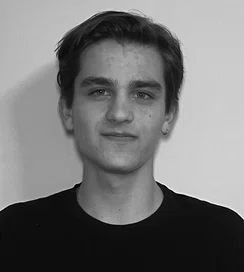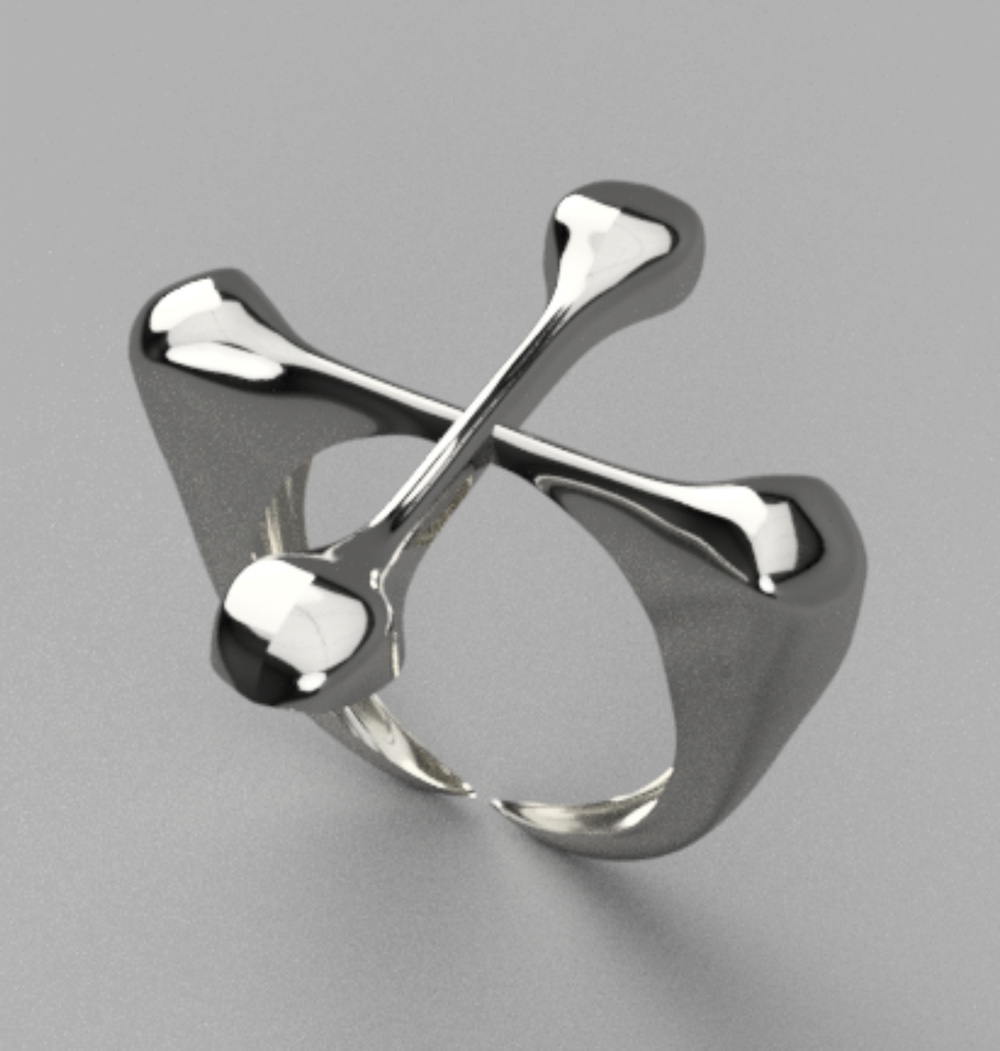
Asher Delman

AP 3-D
Laces Magnet School|Los Angeles, California


Dimensions: 1” x 1” x 1”|Material(s): CAD Program (silver)|Process(es): Ability to find anything: Inspired by an X marks the spot, I interpreted this idea into a ring|Curatorial Note: These CAD designs are fabulous mini ring sculptures that are smart, well designed and ready for someone to figure out how to make them in silver.
Student statement
Student statement
I have loved finding new ways to express myself ever since middle school. In 8th grade, I fell in love with jewelry, specifically rings. As I started wearing rings, I had many ideas of rings I wanted but couldn’t purchase. This led me to learn to create them myself.
I started carving rings in wax; I learned traditional wax carving methods through YouTube and developed my skills there. In my freshman year, I decided that the wax carving method was limiting me artistically, and I started working on my 3-D modeling skills to digitally develop my rings with precise measurements and symmetry. Throughout high school, I designed and produced these rings in silver.
When I took AP Art and Design, I knew I wanted to create rings. However, I wanted a theme that wasn’t only interesting in and of itself but lent well to the chosen medium. I came up with the idea of creating rings inspired by superpowers. I thought, “What would a ring look like if it gave you the superpower it represented?"
I didn’t quite know what to write about in this little excerpt. However, going into my thought process for one of the rings displayed could be interesting. I struggled a bit with the power of language (the piece selected below) as it isn’t the most “literal” concept. I thought of how language is represented and our original interpretations, which led me to the ancient story of the Tower of Babel. I thought this concept was super interesting and wanted to incorporate it into a ring. I played around with a couple of designs to represent the towers falling (referring to the story) and landed on the one you see above.
Art has always been an outlet for me, and I never considered what I did as art before my year in AP Art and Design. My year in the class allowed me to recognize and develop my interest in art and has carried with me since. If I had to give any advice to other AP Art and Design students, it is to do what you enjoy doing. That sounds super obvious and cliche; however, it is so true. In all things, but in art especially, there is no way to force it. Good art comes from an intrinsic desire to create something, whatever that something might be.
If a ring could embody a particular superpower, what might it look like? I wanted to see what ideas (powers) I could interpret in a physical piece with the restraint of it being a ring. As the year progressed, the superpowers I came up with were complicated to personify and much more abstract in form.
Dimensions: 1” x 1” x 1”|Idea(s): I was inspired by how language came to be and came across the myth of the Tower of Babel.|Materials: Silver, Bronze |Process(es): Empathy: Power of empathy inspired by a Venn diagram, meeting in the middle represents empathy.
Teacher statement
Teacher statement
Dan Kuffel
The AP Art and Design course is a wonderful tool to help young artists find and develop their voice. Individual inquiry is the basis of all art. It is based on curiosity and the need to find something. Children are born with vivid imaginations. They create their inquiry and self-expression through increasingly advanced practice, experimentation, and (hopefully) revision. We see this from a young age in a child’s imaginary play and watch it through all the arts. The AP Art and Design portfolio can mark the lifelong path of creative growth through its rigor and personal inquiry.
As teachers, we know growth is tied to practice. At LACES Magnet School, we have students from 6-12th grade. Students may choose up to seven years of tiered visual arts instruction. We have three teachers to support students in a wide variety of disciplines. Our department is collaborative and robust. It allows us to support a range of interests, styles, and concepts while developing a basis in art and design principles.
This scaffolded approach prepares students long before they begin a sustained investigation by giving repeated exposures to materials, techniques, and concepts. Hopefully, a student will have found their voice when a sustained investigation begins. And if not, we still hope to provide every student with a platform for self-expression and skill development. As with all project-based learning, each outcome will be unique to the maker, and skills improve through practice. Experimentation fuels discovery and growth, and revision makes it better.
LACES is Los Angeles Unified School District’s first magnet school. Diversity has been baked into our culture from the beginning, and students attend from every part of Los Angeles and learn from each other. Differences are celebrated here, and open-mindedness is conducive to chance-taking and creativity. Students feel safe and supported in who they are and who they are becoming. This openness fuels creativity in all its forms.
To guide students in their sustained investigations, I insist they choose something central to them. If it’s not essential to the artist, interest will wane.
Successful artists have a sketchbook or journal where random notes and doodles are saved to be elevated to finished work. A notebook is where inquiry begins.
I encourage students to work in small groups to promote the cross-pollination of ideas. Having a sounding board, opposing perspective, friendly ear, or complete collaborator as you create your best work. These also act as informal critiques while the works are developing. Work is shared and refined, and usually, your friends will tell you the truth.
I ask, ”What is your sustained investigation?” often to focus students on staying on track with their specific inquiry and not wandering off on a tangent. Sometimes, the sustained investigation changes to fit the body of work as it develops—almost like a subconscious thought.
Student critiques are good, but often, students shy away from telling difficult truths. Most of us avoid conflict and being the bearer of bad news. That is where good conversations and clear expectations need to be discussed between the student and teacher. Sometimes, conversations are long and ongoing, but the focus is always on how to best elevate the student’s voice and creativity.
I am honored to write this statement because Asher’s work is highly regarded by the College Board. His talent and efforts deserve commendation. He is a gifted jewelry designer who created simple, elegant work with a lot of symbolic power in its conceptual basis. He deserves this honor.
I would also like to speak for our students who struggle with skills and concepts. Their work is not shown here, but their artistic journey is just as valid and deserves celebration. These students deserve a spot in AP Art and Design, where they, too, can express themselves in the visual arts. We need to celebrate their process as well as the product. A sustained investigation portfolio can help launch careers in the arts or help a student share their point of view. Ultimately, It is much more than a score; it is a journey young artists take.
Asher Delman



